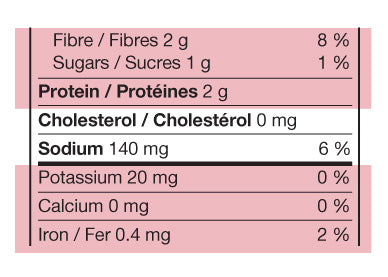How to read a Nutrition Facts label
By Julie Chan, Naturopathic Doctor, Registered Acupuncturist, IV Practitioner
The purpose of nutrition labeling is to provide basic information to help guide consumers in making healthy choices. First implemented in 1913, they provide facts that impact common health concerns such as obesity, high blood pressure and diabetes. In order for a consumer to make the most use out of Nutrition Fact Labels, an individual needs to know their own requirement which is based on gender, age, weight, and health. Here we provide you with a quick guide as to how to read Nutrition Fact Labels properly.
Determining whether a food is healthy for you goes far beyond the Nutrition Facts Label (Click here for more information on ingredients). It is important that we also know how to read the ingredients list. Most processed foods contain a vast number of fillers, preservatives, non-food chemicals, flavouring and colouring agents. These chemicals may be harmful for our health and are generally not advised, and consumption should be kept at a minimum.

Start with the Serving Size
This will tell you the size of a single serving and the total number of servings per container (package)

Check the total calories per serving
Also look at the calories from fat. The acceptable macronutrient daily range of fat intake is 20-35% of your daily calories

Limit these nutrients
Based on a 2,000 calorie diet, it is recommended a daily consumption of no more than 16 grams of saturated fat, as little trans fat as possible, and no more than 1,500 mg of sodium . 1 gram of fat equates to 9 calories so in this nutritional label, there is 8g of fat which equates to 72 calories from fat. You can see there is an error in the above Calories from Fat section.

Get enough of these nutrients The recommended daily fibre intake is 25g for adults and children above 4 years old. Sugar should be limited to 24g in women, 36g in men, 16g in preschoolers, 12g in children 4-8, 20-32g in teenagers. For protein, daily requirements are 0.8 grams per kg of body weight in adults with mild exercise, 1.5 grams per kg in infants, and 0.85 to 1.1 grams of protein per kg of body weight in children. The % of vitamins is a very rough estimate based on an average diet of 2000 calories; know that many people do not fall under this category.

Quick Guide to Daily Values
This tells you the percentage of each nutrient in a single serving, in terms of the daily recommended amount. As a guide, if you want to consume less of a nutrient (such as saturated fat or sodium), choose foods with a lower % DV — 5 percent or less. If you want to consume more of a nutrient (such as fiber), seek foods with a higher % DV — 20 percent or more.

Connect with
Dr. Julie Chan, ND, R.Ac.
Liberty Wellness Clinic
Liberty Square Markham
3621 Highway 7, Suite 307
Markham Ontario, Canada
905-604-8480
